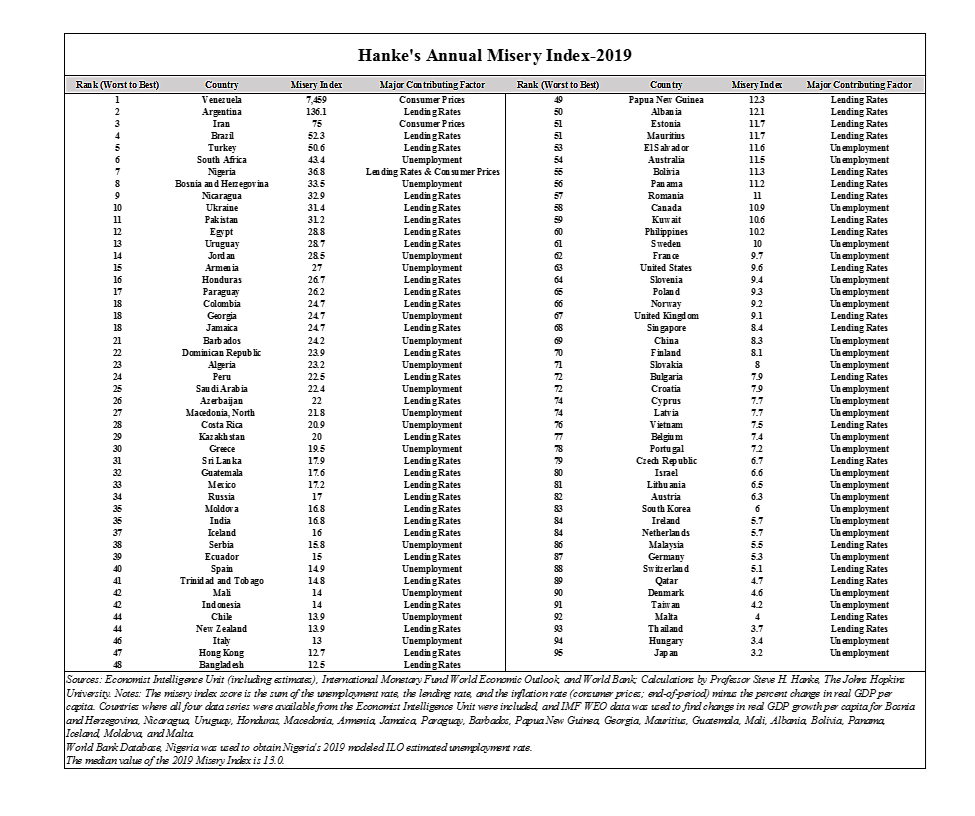The human condition lies on a vast spectrum between “miserable” and “happy.” In the economic sphere, misery tends to flow from high inflation, steep borrowing costs, and unemployment. The most surefire way to mitigate that misery is through economic growth. All else being equal, happiness tends to blossom when growth is strong, inflation and interest rates are low, and jobs are plentiful.
Many countries measure and report these economic metrics regularly. Comparing them, nation by nation, can tell us a lot about where in the world people are sad or happy.
Is Japan, for example, more or less miserable than other countries? To answer this question, I updated the measurements for Hanke’s Annual Misery Index (HAMI).
The first Misery Index was constructed by economist Arthur Okun in the 1960s to provide President Lyndon Johnson with an easily digestible snapshot of the economy. That original Misery Index was a simple sum of a nation’s annual inflation rate and its unemployment rate. The Index has been modified several times, first by Robert Barro of Harvard, and then by me.
My modified Misery Index is the sum of the unemployment, inflation, and bank-lending rates, minus the percentage change in real GDP per capita. Higher readings on the first three elements are “bad” and make people more miserable. These are offset by a “good” (GDP per capita growth), which is subtracted from the sum of the “bads.” A higher Misery Index score reflects a higher level of “misery.” It’s a simple enough metric that can be understood at a glance. The accompanying table contains Misery Index rankings for the 95 nations that report relevant data on a timely basis.

Let’s start with three of the least miserable countries and work down into the pits.
Japan takes the prize as the world’s least miserable country, moving up from the third-least miserable in 2018. It’s no surprise that prime minister Shinzo Abe remains firmly in the saddle.
Hungary delivers yet another stunner. It ranks as the second-least miserable country in the world. While the European Union and the international elites have thrown everything they can at prime minister Viktor Orban, it’s easy to see why he commands a strong following at home. After all, the Magyars held the second-happiest spot in the world in 2018 as well.
Thailand has slipped from the least miserable country in the world in 2018 to the third-least miserable in 2019. The military junta delivered happiness in 2018 and 2019, and as a result, the pro-military PPRP was rewarded at the polls.
On the bright side, buried in the HAMI table are two countries that improved (reduced misery) the most: Mauritius and Papua New Guinea. Due to a plunge in its annual inflation rate in 2019, Mauritius moved from 31st to 51st most miserable — a significant improvement. Papua New Guinea also rose in happiness and thus in the rankings, moving from 29th in 2018 to 49th in 2019. This was largely because GDP growth swung from a contracting ‑3.1 percent per year to an expanding 2.8 percent per year.
Now, let’s take a deep dive into the bottom of the pits.
Venezuela holds the inglorious title of the most miserable country in the world in 2019, as it did in 2018, 2017, 2016, and 2015. The failures of president Nicolás Maduro’s corrupt, socialist petroleum state have been well documented over the past year. However, behind the shroud of secrecy that covers Venezuela, a great deal of change occurred in the components of HAMI in 2019. Inflation, while still the world’s highest, came down. On the other hand, the unemployment rate surged to 24 percent from 14.9 percent in 2018, while GDP per capita took a dive from ‑16.5 percent per year to ‑32.2 percent per year.
Argentina held down the second-most miserable spot after yet another peso crisis. Since its founding, Argentina has endured numerous economic crises. Most can be laid at the feet of domestic mismanagement and currency problems (read: currency collapses). Such crises have occurred in 1876, 1890, 1914, 1930, 1952, 1958, 1967, 1975, 1985, 1989, 2001, 2018, and 2019, to name but a few. Until Argentina dumps the beleaguered peso and replaces it with the U.S. dollar, it will be, well … miserable.
Iran, our No. 3, is, like Argentina, burdened with the weight of a non-credible central bank and a junk currency. The only way out is to make the rial as good as gold with a gold-backed currency board.
Brazil held down the fourth-most miserable spot in the ranking. As my close friend Roberto Campos — the late Brazilian economist, diplomat, and politician — once explained to me: The Brazilian Constitution is as thick as the New York City telephone book and is full of little more than rights and entitlements. President Bolsonaro has his work cut out for him. To improve his country’s ranking, he will have to deliver more than his recent pension reforms.
The two biggest negative moves in 2019 were Pakistan and Moldova, with Pakistan sliding from the 34th most miserable in 2018 to the 11th most miserable in 2019. For its part, Moldova moved from the 66th most miserable country in 2018 to the 35th in 2019.
Countries’ national attitudes have a vast range of overall conditions by my metric. But the currently most miserable should take heart that it is possible to improve. And the currently least miserable should note that they, too, can fall into despair.
